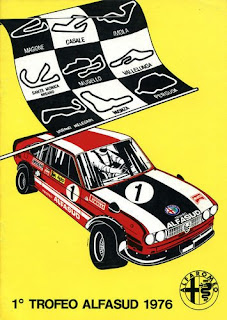When I started working at BMW Concessionaires GB Ltd in 1971, our cars were not ten-a-penny on London’s more affluent streets. The trendy thing to drive then was an Alfa Romeo. The 105 Series Giulia models offered a heady mix of great styling, courtesy of Bertone and Pininfarina, together with exhilarating performance reflecting the Marque’s racing successes, primarily with the brilliant GTA variant. On my first visit to Munich, I was told that with the impending Tii version of the 2002 and further development of the E9 coupe, it was hoped that Alfa would find itself with a worthy Bavarian competitor. By the time I moved to Alfa Romeo GB Ltd. (ARGB) at the end of the decade, places like Kensington and Hampstead were knee-deep in BMWs, whereas, though its UK registrations were peaking, Alfa Romeo’s reputation and market share was beginning its woeful decline. Both the sales volume zenith and the collapse of esteem for the Marque’s products were mainly attributable to the Alfasud.
Whatever the big picture aspects of the Alfasud in terms of its commercial viability and effect on Alfa Romeo’s prestige, its specification made for the basis of an excellent small racing saloon, given its light weight, compact footprint, rev-happy flat four engine and inboard front brakes. In standard form the throttle response was very good and it was soon found that even with just the substitution of carburettor make/model – Weber or Dellorto – increased horsepower was relatively easy to achieve. With numbers of ‘Sud’s appearing on circuits in 1975 – notably in Austria - recognising the promotional potential, Alfa Romeo instituted the ‘Alfasud Trofeo’ race series in 1976. The version to be used was the 1.3 Ti which had supplemented the range in ’73, initially in 1200 cc form. The car could be modified by the use of an Autodelta-marketed kit of parts. In standard production specification the Ti’s engine produced 75 bhp, whereas a Trofeo version managed 115 bhp on the twin Webers included in the Autodelta kit. Given a minimum weight of 800 kgs, this made for a quick car, further enhanced by the other kit components which included competition exhaust, springs and dampers, wheel arch extensions and lightweight Campagnolo alloys. In Italy the series was comprised of 9 races, at Magione, Casale Monferrato, Imola, Misano, Mugello, Vallelunga, Varano, Monza and Pergusa.

The
inaugural championship was won by a clear margin by Filippo Niccolini, from Claudio
Pizzi. Niccolini was the victor at five
of the championship rounds. His car was
advertised for sale in 2016 by Weekend Heroes of Munich:
With
increasing awareness across Europe, Trofeo series were also introduced
in Austria, Germany and France. Confirming
the high level of interest from competitors, circuits and enthusiasts, 1977
also saw the establishment of a ‘Trofeo Europa Alfasud,’ bringing
together the better drivers from the various national series.
The Europa series
gained additional attention by the running of some rounds as support races to
Formula One Grands Prix. First champion
was Italy’s Aldo Cerruti. Notable among
the Trofeo Europa competitors was Gerhard Berger, future F1
high-achiever with McLaren and Ferrari, who took seventh place in 1981.
 |
Gerhard Berger and his Trofeo Alfasud
|
Alfasud
Trofeo
racing tended to be close and frantic, as can be seen in the photograph below:
In
the UK, Alfasuds also appeared on-track in 1976, run by the Campari-sponsored Dealer
Team. Two cars were entered to the Tourist
Trophy for Jon Dooley/Simon Kirby/Rex Greenslade. Another ‘Sud was entered for this event by
the stalwart Bolton dealership, Westune – drivers, Malcolm Wayne/John
Myerscough.
From 1977, examples of the
Sprint variant began to compete. In Division
1 (1300) of the European Touring Car Championship, Sprints of Team
43-70 were class winners in 9 of the 11 rounds and clear class champions.
Sprint of
Marquez/Perrado (Team 43-70) at Brno, ETCC, 1977
1978
proved to be a much tougher year for the Sprints in the ETCC. Of the twelve rounds, a Sprint was able to
take the class victory at only two events – at the Nurburgring and Silverstone. Early in the season, Fiat 128 Coupes and Alfa
GT Juniors had better pace, and, later, the Skoda 130RS proved superior. However, a Sprint was 1st in class
at 5 races, and consistent results from the Belgian pair, Richard Mattozza and Jacques
Berger, were a major contribution towards Alfa Romeo securing the
manufacturer’s Division 1 championship. But by the end of the decade, the ‘Sud in both
Berlina and Sprint form was not a significantly competitive race car, and
results were mediocre at best.
Development of the Alfasud
during the late Seventies/early Eighties took production versions’ power output
up to 105 bhp, with the 1.5 litre capacity engine. The Sprint eventually gained a 1.7 variant,
and this boasted 112 bhp. Nevertheless,
neither this car, nor the ‘Sud’s replacement, the 33, were found to be a good
basis for a competitive racing car. At
ARGB we dabbled with a turbocharged version of the 33, (around 130 bhp), in
conjunction with Terry Drury Racing, but this too proved to be an ineffective
circuit racer. So there was quite a hiatus
in motorsport terms, before the advent of the 155, which would certainly turn
out to be a formidable and successful touring car for the Marque.






No comments:
Post a Comment